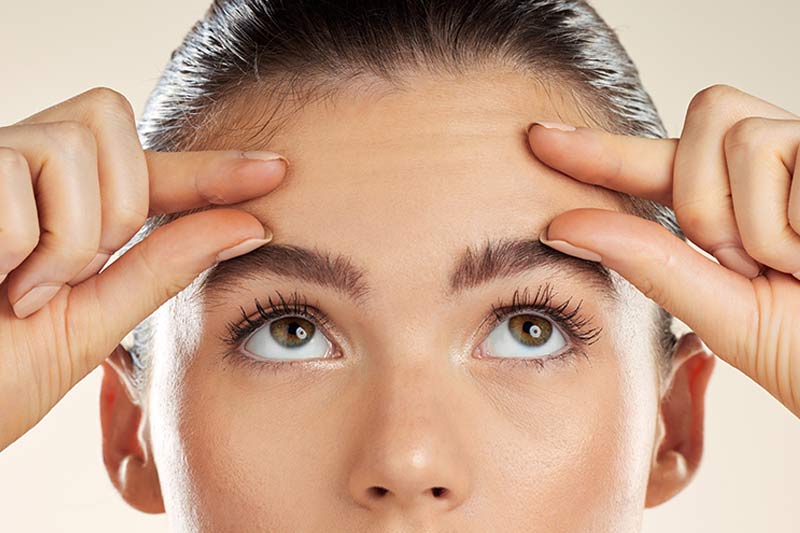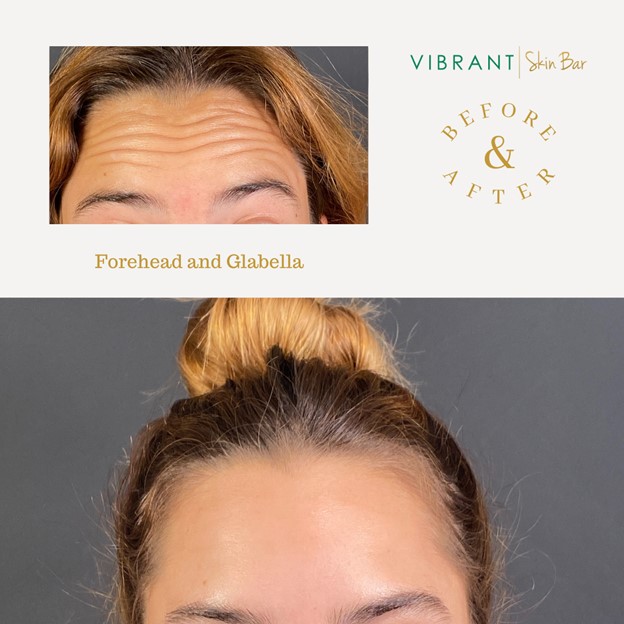The popularity of Botox has turned this brand name into a verb to describe any successful facial skin rejuvenation activity. If you get dermal fillers or your anti-aging serum has magical effects, you may be mistaken for someone who “Botoxed” their face.
The forehead is one of the most common Botox areas. Let’s see why Botox is such a popular way to reduce forehead lines, what the procedure looks like, and how efficient it is.

Is Botox Safe to Use on the Forehead?
The FDA approved Botox for cosmetic purposes in 2002. Initially, Botox was approved for glabellar (frown) lines and crow’s feet. Forehead Botox received approval from the FDA in 2017.
Millions of people use Botox for forehead wrinkles each year. Scientists have published hundreds of articles about the treatment’s safety and effectiveness, showing it rarely causes severe side effects. The product is manufactured under strict safety standards and practice shows adverse effects are minimized when experienced medical professionals perform the treatment.
Note: Our board-certified medical providers at Vibrant Skin Bar have years of experience injecting Botox and hundreds of satisfied patients.
Why Is Botox Used on the Forehead?
The forehead is a top area of concern for patients. It is the area where horizontal wrinkles form due to the movement of the frontalis muscle, which contracts when we lift the eyebrows in surprise, wonder, awe, and other reactions.
Forehead wrinkles are among the most common signs of premature aging skin and Botox can effectively eliminate them, smoothing the forehead and rejuvenating the patient’s look.
What Is the Best Age to Start with Botox Treatments?
Our skin cells start aging in our 20s. Many people start preventative Botox treatments around this time, especially if their forehead lines are showing.
Patients report that regular, long-term Botox use can prolong the treatment’s effectiveness and cause the muscles to contract less even without the neurotoxin. As a result, the formation of dynamic wrinkles on the forehead slows down.
The earlier you start using Botox for your forehead, the longer it will appear smooth and youthful. If you start using Botox for your forehead later in life, when you’ve already developed prominent wrinkles, the effects may not be as visible. The injections will reduce the appearance of wrinkles, but they may not fully eliminate them.
Forehead Botox: What to Expect
Forehead Botox is a Botulinum toxin injection designed to temporarily reduce the appearance of parallel forehead wrinkles. It involves injecting the neurotoxin into target muscles to block nerve signals and relax their movement. It is a quick, in-office procedure that requires no downtime.
Forehead Botox: Before & After
Patients who come in for the forehead Botox treatment usually have visible lines across the forehead. The medical provider typically asks the patient to lift the eyebrows while they take a picture of the area.
After the treatment, the patient’s forehead is smoother and more radiant. The wrinkles are eliminated or minimized, depending on the initial state of the patient’s skin.
The patient’s ability to lift their eyebrows is somewhat limited, but they can still make natural facial expressions.

Forehead Botox: The Procedure
The medical provider first cleans the patient’s skin with rubbing alcohol and applies numbing cream to the injection site to prevent pain from the injection. They inject a small dose of Botox into the frontalis muscle and the glabella (between the brows).
The injection procedure lasts only a few minutes, and the whole session usually takes about 30 minutes. Patients may feel slight discomfort from the needle, but no pain, and the treatment requires no downtime.
Note: Make the most of your treatment - learn how to prepare for Botox to achieve optimal results.
Forehead Botox Aftercare
After the treatment, patients can resume their daily routine. Experts recommend patients refrain from those activities that can cause the neurotoxin to migrate from the injection spot. These typically include:
- Washing your face after Botox during the first 24 hours.
- Cardio exercise during the first 24 hours.
- Bending after Botox or lying down for at least four hours.
- Sun and heat exposure during the first 24 hours.
- Drinking alcohol after Botox during the first 24 hours.
- Other facial skin treatments as advised by your doctor.
Note: For more Botox aftercare tips, consult our blog article.
When Do the Results of Forehead Botox Become Visible?
Patients usually notice the first results after common side effects, such as mild bruising and swelling, subside. This may take a few days. The injection typically takes full effect one week after the procedure.
How Long Does the Effect of Botox Last in the Forehead?
The effects of forehead Botox usually last three to six months. The longevity of the results depends on many factors, including the patient’s metabolism, level of physical activity, lifestyle habits, and Botox dosage.
To get the most out of your neurotoxin’s anti-wrinkling effects, schedule another treatment three to four months after the last session.
How Often Can You Get the Forehead Botox Treatment?
It is safe to receive Botox every three to six months. Botox providers don’t recommend more frequent sessions to avoid developing Botox resistance.
Forehead Botox Side Effects: Are There Any?
The most common side effects of forehead Botox are swelling and bruising at the injection site. Fortunately, there are things you can do to prevent bruising after Botox.
A headache and drooping eyelids are less common Botox side effects.
Allergic reactions, difficulty breathing and swallowing, dry mouth, rashes, fatigue, and blurred vision are very rare after Botox. Contact your medical provider if you experience any of these serious adverse effects.
Note: Botox has an excellent safety profile but, like any intervention, causes some side effects. Learn more about what Botox side effects are expected and what to do to prevent them.
How Much Does Forehead Botox Cost?
The average cost of forehead Botox depends on many factors, including the medical provider’s expertise, the clinic’s location, and how many Botox units the patient needs. One Botox unit costs $10 - $20. Forehead Botox treatment costs usually range from $200 to $600.
How Many Units of Botox Are Required for the Forehead?
Medical practitioners usually inject two areas of the forehead to get an overall smoothing effect and reduce the chances of drooping brows. On average, 10-24 units of Botox are injected in the frontalis muscle to smooth horizontal wrinkles, and 20 units are injected in the glabellar complex between the brows.
Men tend to have larger and stronger muscles and usually require a higher dose. The average dose for men is 24 units in the glabellar complex and 20 units in the frontalis muscle.
Of course, the number of Botox units needed for forehead wrinkles depends on how prominent the wrinkles are and the patient’s desires. The practitioner determines the exact number of units during a pre-treatment consultation.
Where Can You Get Forehead Botox?
If you are in the Phoenix, AZ, area, we invite you to visit our friendly medical professionals and long-time Botox providers at Vibrant Skin Bar.
At Vibrant Skin Bar, one Botox unit costs $13.50. The forehead Botox session may cost between $125 and $550, depending on the severity of your wrinkles and what you wish to achieve.
Conclusion
Forehead wrinkles are among the first signs of aging. Thankfully, Botox successfully treats lines across the forehead, giving us the smooth, wrinkle-free look we love. The treatment is quick, minimally invasive, and affordable. Keeping youthful-looking skin as we age is no longer impossible.
Botox - Buy Now, Use Later for $12/unit


